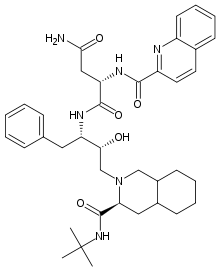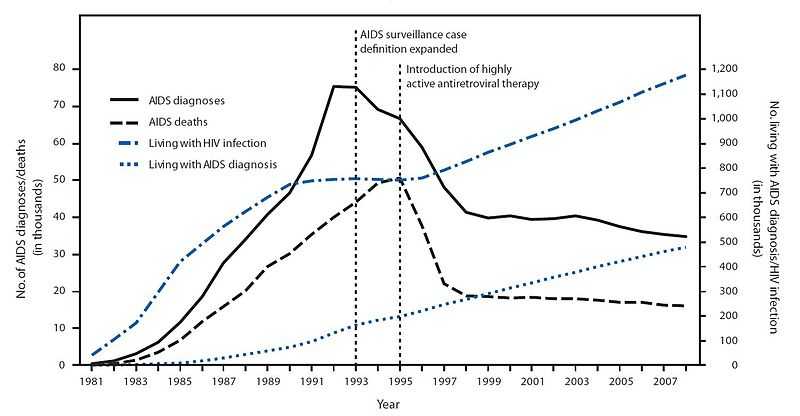Saquinavir
 | |
 | |
| Systematic (IUPAC) name | |
|---|---|
| (2S)-N-[(2S,3R)-4-[(3S)-3-(tert-butylcarbamoyl)-decahydroisoquinolin-2-yl]-3-hydroxy-1-phenylbutan-2-yl]-2-(quinolin-2-ylformamido)butanediamide | |
| Clinical data | |
| Trade names | Invirase |
| AHFS/Drugs.com | monograph |
| MedlinePlus | a696001 |
| |
| Pharmacokinetic data | |
| Protein binding | 98% |
| Half-life | 9 - 15 hours |
| Identifiers | |
|
127779-20-8 | |
| J05AE01 | |
| PubChem | CID 441243 |
| DrugBank |
DB01232 |
| ChemSpider |
390016 |
| UNII |
L3JE09KZ2F |
| KEGG |
D00429 |
| ChEMBL |
CHEMBL114 |
| NIAID ChemDB | 000640 |
| Chemical data | |
| Formula | C38H50N6O5 |
| 670.841 g/mol | |
|
SMILES
| |
| |
| | |
Saquinavir is an antiretroviral drug used in HIV therapy. It falls in the protease inhibitor class. Two formulations have been marketed:
- a hard-gel capsule formulation of the mesylate, with trade name Invirase, which requires combination with ritonavir to increase the saquinavir bioavailability;
- a soft-gel capsule formulation of saquinavir (microemulsion,[1] orally-administered formulation), with trade name Fortovase, which was discontinued worldwide in 2006.[2]
Saquinavir is used as a component of highly active antiretroviral therapy (HAART).
It is on the World Health Organization's List of Essential Medicines, a list of the most important medication needed in a basic health system.[3]
Mechanism of action
Saquinavir is a protease inhibitor. Proteases are enzymes that cleave protein molecules into smaller fragments. HIV protease is vital for both viral replication within the cell and release of mature viral particles from an infected cell. Saquinavir binds to the active site of the viral protease and prevents cleavage of viral polyproteins, preventing maturation of the virus. Saquinavir inhibits both HIV-1 and HIV-2 proteases.
Adverse reactions
The most frequent adverse events with saquinavir in either formulation are mild gastrointestinal symptoms, including diarrhea, nausea, loose stools & abdominal discomfort. Invirase is better tolerated than Fortovase.
Bioavailability and drug interactions
Saquinavir, in the Invirase formulation, has a low and variable oral bioavailability, when given alone. The Fortovase formulation at the standard dosage delivers approximately eightfold more active drug than Invirase, also at the standard dosage.[4]
In the clinic, it was found that the oral bioavailability of saquinavir in both formulations significantly increases when patients also receive the PI ritonavir. For patients, this has the major benefit that they can take less saquinavir, while maintaining sufficient saquinavir blood plasma levels to efficiently suppress the replication of HIV.
The mechanism behind this welcome observation was not directly known, but later it was determined that ritonavir inhibits the cytochrome P450 3A4 isozyme. Normally, this enzyme metabolizes saquinavir to an inactive form, but with the ritonavir inhibiting this enzyme, the saquinavir blood plasma levels increased considerably. Additionally, ritonavir also inhibits multidrug transporters, although to a much lower extent.
Unlike other protease inhibitors, the absorption of saquinavir seems to be improved by omeprazole.[5]
History

Saquinavir was developed by the pharmaceutical company Roche. Saquinavir was the first protease inhibitor (and sixth antiretroviral) approved by the Food and Drug Administration (FDA). Within 2 years of its approval, and that of ritonavir 4 months later, annual deaths from AIDS in the United States fell from over 50,000 to approximately 18,000.[7] The manufacturer, Roche, requested and received approval of Invirase via the FDA's "Accelerated Approval" program, a process designed to speed drugs to market for the treatment of serious diseases. This decision was controversial, amid disagreement between AIDS activists over the benefits of thorough testing versus early access to new drugs.[8]
It was approved again on Nov 7, 1997 as Fortovase, a soft gel capsule reformulated for improved bioavailability. Roche announced in May 2005 that, owing to reduction in demand, Fortovase would cease being marketed early in 2006 in favour of Invirase boosted with ritonavir.[9]
References
- ↑ Gibaud, S. P.; Attivi, D. (2012). "Microemulsions for oral administration and their therapeutic applications". Expert Opinion on Drug Delivery: 1. doi:10.1517/17425247.2012.694865.
- ↑ News-Medical.Net. May 18, 2005 Roche to discontinue the sale and distribution of Fortovase (saquinavir)
- ↑ "WHO Model List of EssentialMedicines". World Health Organization. October 2013. Retrieved 22 April 2014.
- ↑ FortovaseTM (saquinavir) soft gelatin capsules. Product information (November 1997)
- ↑ Winston A; Back D; Fletcher C et al. (2006). "Effect of omeprazole on the pharmacokinetics of saquinavir-500 mg formulation with ritonavir in healthy male and female volunteers". AIDS 20 (10): 1401–6. doi:10.1097/01.aids.0000233573.41597.8a. PMID 16791014.
- ↑ "www.cdc.gov".
- ↑ "HIV Surveillance --- United States, 1981--2008". Retrieved 8 November 2013.
- ↑ "Drugs! Drugs! Drugs! An Overview of the Approved Anti-HIV Medications". The Body. Retrieved 20 February 2013.
- ↑ Withdrawal of Fortovase (PDF)
External links
- Saquinavir bound to proteins in the PDB
Further reading
- Cohen Stuart JW, Schuurman R, Burger DM, et al. (1999) Randomized trial comparing saquinavir soft gelatin capsules versus indinavir as part of triple therapy (CHEESE study). AIDS 13:F53-58
- Dragsted UB, Gerstoft J, Pedersen C, et al. (2003) Randomized trial to evaluate indinavir/ritonavir versus saquinavir/ritonavir in human immunodeficiency virus type 1-infected patients: the MaxCmin 1 Trial. J Infect Dis 188:635-642